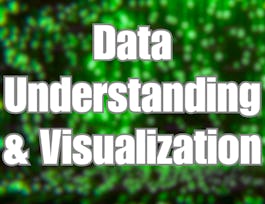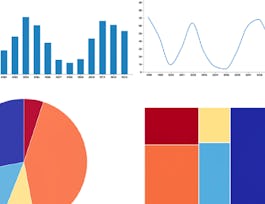This is the first course in the four-course specialization Python Data Products for Predictive Analytics, introducing the basics of reading and manipulating datasets in Python. In this course, you will learn what a data product is and go through several Python libraries to perform data retrieval, processing, and visualization.



Basic Data Processing and Visualization
This course is part of Python Data Products for Predictive Analytics Specialization


Instructors: Julian McAuley
Sponsored by Coursera Learning Team
21,138 already enrolled
(193 reviews)
Recommended experience
What you'll learn
Develop data strategy and process for how data will be generated, collected, and consumed
Load and process formatted datasets such as CSV and JSON.
Deal with data in various formats (e.g. timestamps, strings) and filter and “clean” datasets by removing outliers etc.
Basic experience with data processing libraries such as numpy and data ingestion with urllib, requests
Skills you'll gain
Details to know

Add to your LinkedIn profile
12 assignments
See how employees at top companies are mastering in-demand skills

Build your subject-matter expertise
- Learn new concepts from industry experts
- Gain a foundational understanding of a subject or tool
- Develop job-relevant skills with hands-on projects
- Earn a shareable career certificate


Earn a career certificate
Add this credential to your LinkedIn profile, resume, or CV
Share it on social media and in your performance review

There are 5 modules in this course
This week, we will go over the syllabus and set you up with the course materials and software. We will introduce you to data products and refresh your memory on Python and Jupyter notebooks.
What's included
6 videos6 readings2 assignments2 discussion prompts
This week, we will learn how to load in datasets from CSV and JSON files. We will also practice manipulating data from these datasets with basic Python commands.
What's included
6 videos3 assignments1 discussion prompt
This week, our goal is to understand how to clean up a dataset before analyzing it. We will go over how to work with different types of data, such as strings and dates.
What's included
4 videos3 assignments1 discussion prompt
In this last week, we will get a sense of common libraries in Python and how they can be useful. We will cover data visualization with numpy and MatPlotLib, and also introduce you to the basics of webscraping with urllib and BeautifulSoup.
What's included
5 videos4 assignments1 peer review2 discussion prompts
Create your own Jupyter notebook with a dataset of your own choosing and practice data manipulation. Show off the skills you've learned and the libraries you know about in this project. We hope you enjoyed the course, and best of luck in your future learning!
What's included
1 video2 readings1 peer review1 discussion prompt
Instructors


Offered by
Why people choose Coursera for their career




Learner reviews
193 reviews
- 5 stars
62.69%
- 4 stars
21.76%
- 3 stars
7.25%
- 2 stars
3.62%
- 1 star
4.66%
Showing 3 of 193
Reviewed on Jun 29, 2022
Great content. When you apply yourself to this course , there's no "dirty" data you can't handle.
Reviewed on Nov 19, 2020
Goes into great detail on ways to actually use the code in sophisticated and useful ways. I feel like this course has started me on building a great python toolkit.
Reviewed on Sep 16, 2020
This course is more rewarding than I thought. The instructors give step by step explanation of the process also the syllabus of the course is just perfect, Highly recommended.
Recommended if you're interested in Data Science

University of Colorado Boulder

University of California San Diego

Microsoft

University of Colorado Boulder

Open new doors with Coursera Plus
Unlimited access to 10,000+ world-class courses, hands-on projects, and job-ready certificate programs - all included in your subscription
Advance your career with an online degree
Earn a degree from world-class universities - 100% online
Join over 3,400 global companies that choose Coursera for Business
Upskill your employees to excel in the digital economy


